
Some of you may know it as horsetail, a short wiry rough green plant that inhabits moist and damp forests, lake shores and riversides, marshes and swamps. Because of the abrasive silicates in the horsetail, it is also called ‘scouring rush’ and is useful for scouring cooking pots or drinking mugs. It is appropriately called horsetail given how its wiry drooping branches resemble a horse’s tail. The common horsetail’s Latin name is Equisetum arvense and belongs to the subclass Equisetidae, which reproduce by spores, not seeds.
The common horsetail is in fact a miniature descendant of a once diverse plant lineage of ancient sphenopsids that dominated the understory of the coal swamps of the Paleozoic forests. Equisetum is the only living genus of the Equisetidae, making it a living fossil to a time older than the dinosaurs. Today only fifteen horsetail species exist and all are less than a metre high. Over three hundred million years ago some Equisietidae like Calamites were large trees, reaching 20 metres (66 ft) tall, higher than today’s oaks and beeches.
Calamites, Tree Ancestor to the Common Horsetail
Calamites was a spore-bearing tree-size sphenopsid that lived in the Carboniferous and early Permian Periods of the late Paleozoic Era (about 360 to 250 million years ago). Calamites trunks were thick segmented stems with ribbed surfaces, like bamboo. The stems were also hollow, like bamboo, and when they died and fell they often split open. Like ferns, Calamites were spore-bearing plants; they carried the spores in elongate fruits that resembled cones of pine trees (similar to the strobilus of today’s horsetail). Calamites also spread through rhizomes to create clone plants (just like Aspens do today). Their leaves were needle-like and arranged in whorls that radiated out from a central point; sequences of whorls extended from stems on the trunks.
Where and When Calamites Lived
Calamites began during the Mississipian and proliferated during the Pennsylvanian of the Carboniferous Period. These sphenopsids lived in the steamy ‘equatorial’ rainforest swamps that covered the vast continent and coastal shallows of tropical Laurasia (Europe, Asia, and North America) and Cathaysia (mainly China) during the Carboniferous Period. Warm and humid coastal shallows accumulated large amounts of peat, rich in stored carbon.
By the end of the Pennsylvanian, Calamites declined and became extinct by the early Permian Period. After millions of years of heat and pressure, the buried remains of the Calamites and other giant plants of its ecosystem, were transformed into coal reserves. The anoxic conditions of the swampy environment and the lack of microorganisms to break down the plants (they hadn’t evolved yet!) prevented the plant material from decaying; instead, the dead plant material formed peat (as in our current bogs and fens), which held in the carbon they had taken in. Given the lack of a decay process, no carbon was released and instead this energy was locked in the coal forest for millions of years. Yielding to heat and pressure and sedimentation events from inundating seas, the forest peat biomass transformed to coal and this was ultimately released through mining by humans millions of years later.
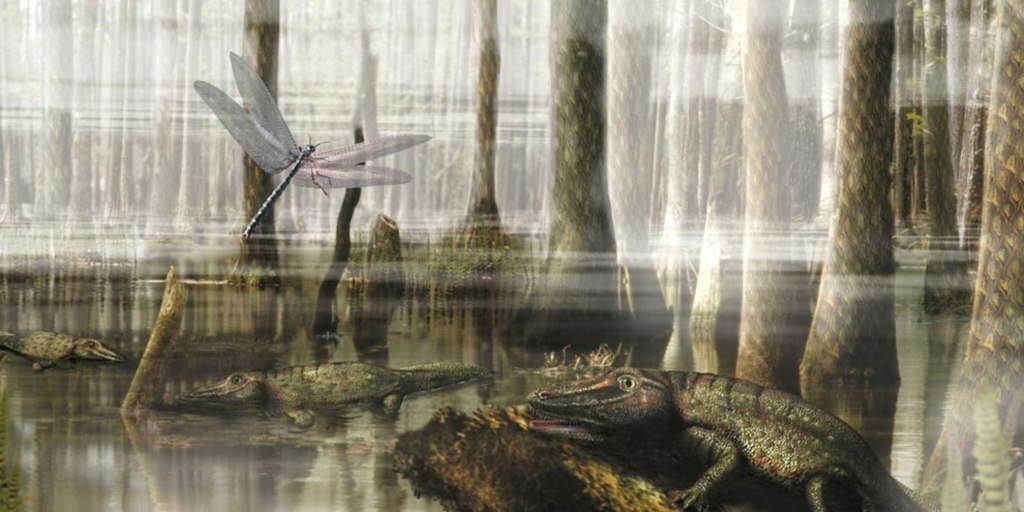
Imagine these prehistoric swamps, buzzing with giant insects, and dense with algae, filter-feeders, and amphibian-like tetrapods. Out of these murky swamps emerged bizarre trees covered in bark and as high as a pine tree, but with branches arranged in whorls. Calamites stood mostly along the sandy banks of rivers and sprouted vigorously from underground rhizomes, particularly when the upper portions of the plant were damaged—not unlike the highly successful and ubiquitous black locust or poplar trees of today.

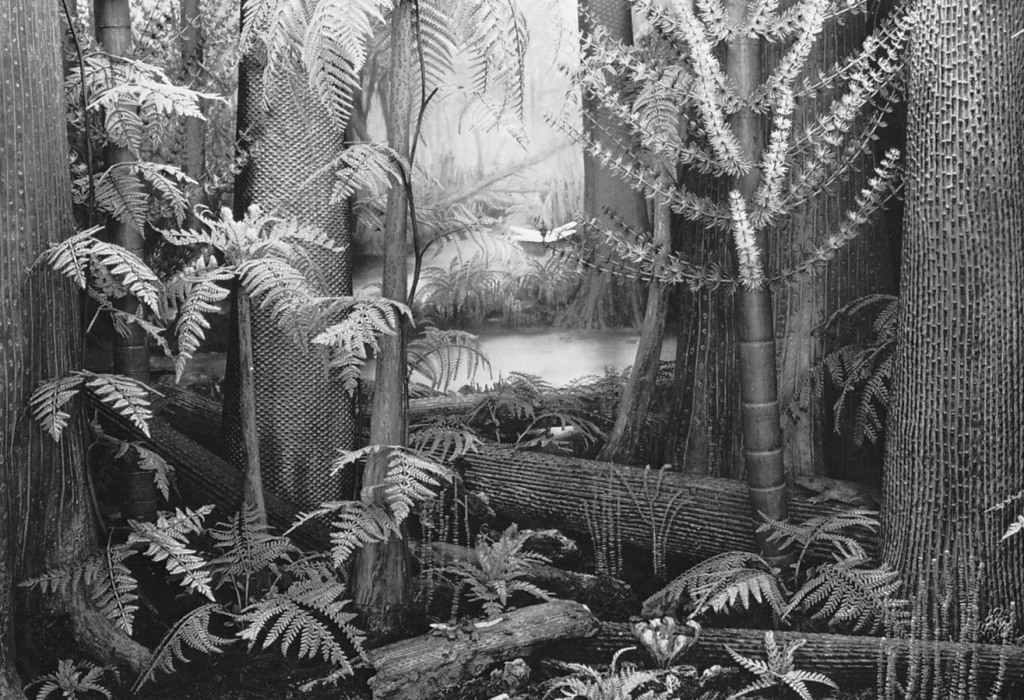


Along with Calamites, the vast lowland swamp forests were crowded with: giant club mosses (arborescent lycopsids such as Sigillaria and Lepidodendron); tree ferns (such as Psaronius, whose descendants [Cyathea australis and Dicksonia antartica] you can still find rising up to 25 m high in the jungles of Australia); seed ferns such as Medullosa that looked like palm trees with seeds as large as avocados; herbaceous vine-like horsetails such as Sphenophyllum; and Cordaites (early relatives of conifers) with strap-shaped leathery leaves.
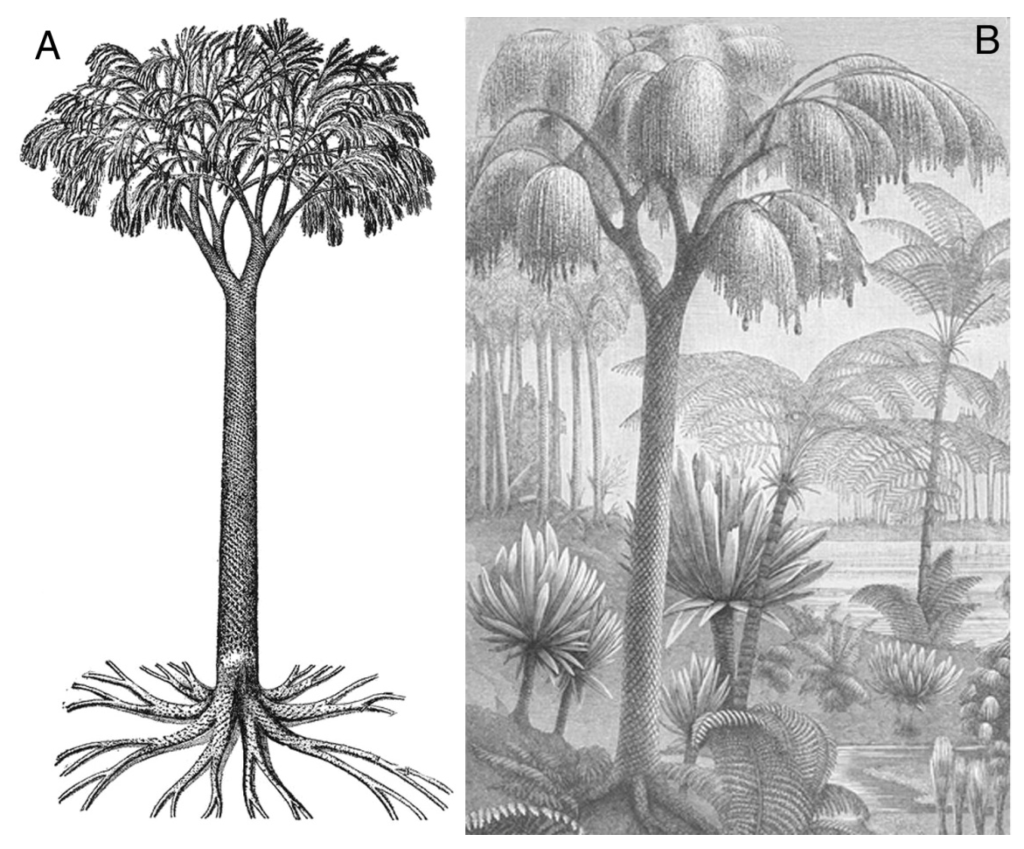
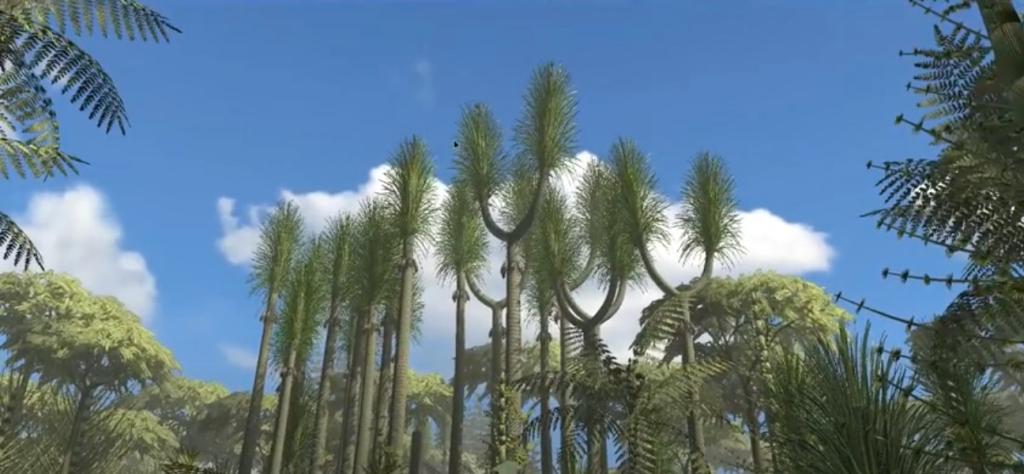


The Coal Forests of the Carboniferous Period
While shallow, warm, marine waters often flooded the continents during the Carboniferous Period, major geological changes occurred. Africa collided with eastern North America in the late Pennsylvanian, an event that formed the Appalachian Mountains. Vast coal swamps stretched across the lowlands to the west of the rising mountains. By the end of the Carboniferous, the Earth’s landmasses were moving toward a single, global supercontinent called Pangaea.
Geologically, the Late Carboniferous collision of Laurasia into Gondwana (present-day Africa, South America, Antarctica, Australia, and India) produced the Appalachian Mountain belt of eastern North America and the Hercynian Mountains in the United Kingdom. A further collision of Siberia and eastern Europe created the Ural Mountains of Russia. Climatically, a trend towards mild temperatures during the Carboniferous, saw a decrease in lycophytes and large insects, and an increase in the number of tree ferns.

The Age of Oxygen & the Giant Insects
According to National Geographic, the growth of the Carboniferous swamp forests gave off oxygen and removed huge amounts of carbon dioxide from the atmosphere, burying the plants under the swamps and the carbon along with them. Atmospheric carbon dioxide eventually dropped and atmospheric oxygen levels peaked around 35 percent, compared with 21 percent today. High oxygen levels allowed plants and animals to reach sizes not known in today’s atmosphere and to further diversify. Insects, which breathe by the diffusion of air through their exoskeletons, rather than using lungs or gills, exploited the surplus oxygen to grow to immense sizes. Gigantic insects thrived in the forest swamps of the Carboniferous. Three-metre (10 ft) long poisonous millipedes (Arthropleura) crawled among giant cockroaches and scorpions a metre (3 ft) long. Mayflies were abundant and dragonflies grew to the size of seagulls; the wingspan of Megalneura reached 2.5 ft. Many amphibians were predatory species that resembled modern-day crocodiles. Armed with vicious teeth, they reached lengths of almost six metres (20 ft). Amphilbamus, Phlegethontia and Eryops had large skulls, small trunks and stocky limbs.
Club Mosses (Lycophytes) Dominated the Coal Forests
Earth History describes how the Carbonifrous swamp forests were dominated by giant club mosses, particularly Sigillaria (with ribs and round leaf bases) and Lepidondendron or Scale Tree (with diamond-shaped leaf bases and scaly trunk). According to fossil logs, Estrellamountain.edu describe the leaves of Lepidondendron as simple and resembling blades of grass; they were spirally arranged up the entire stem; as the plant grew, older leaves fell off, leaving diamond-shaped scars where they once attached. Lepidondendron reached nearly 40 meters (130 ft) high and its photosynthetic trunk reached nearly 2 meters in diameter.
Earth History describes these 30-40-metre high tree-like mosses as having, “almost no woody tissue. Instead the trunk was filled with pith and strengthened by a thick cortex, which extended from the cambium outwards to a bark-like, decay-resistant periderm. Long grassy leaves grew from the trunk, and following leaf-fall the scars on the leaf cushions composed a distinctive geometric pattern. In contrast to the brown, non-photosynthetic stems of modern trees, photosynthesising bark covered the whole trunk. Only towards the end of their lives did they form lateral branches and put out a leafy crown, to reproduce before they died, by means of spore-bearing cones.”
Just as with the alder tree of today (which creates silt-roots for oxygen intake and whose wood can withstand being under water without rotting), the ancient club moss tree roots were designed to float and were hollow.
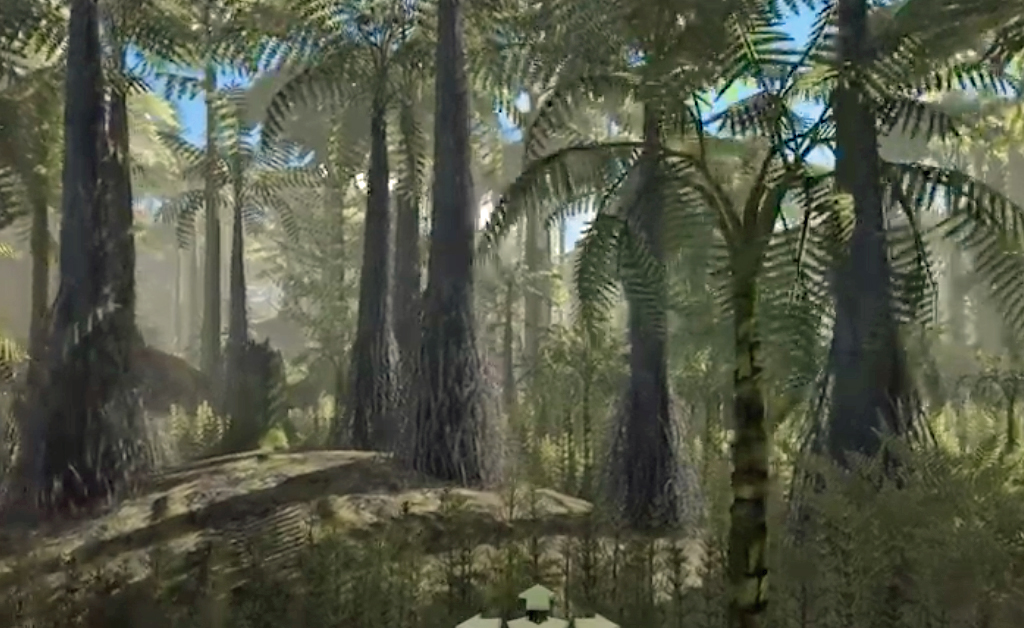
As their watery habitats dried out toward the end of the Carboniferous Period, the arborescent lycophytes died out; horsetails and tree ferns rose to dominate the late Carboniferous into the Permian. However, the giant Calamites died out in the early Permian and the herbaceous vine form Sphenophyllum continued into the Triassic Period; the Equisetum we know today, the Common Horsetail, emerged around 135 mya in the Jurassic/Cenozoic Period of the Mesozoic Era). While the tree fern Psaronius went extinct along with the Permian Period’s mass extinction, tree ferns have continued into the present day with Dicksonia and Cyathea. Unlike seed ferns, tree ferns such as Psaronius reproduced like modern ferns using spores, which are distributed by wind from growths called sporangia on the leaves. These tree ferns didn’t have growth rings like modern trees; instead, the ‘tree’ was supported by a fibrous mantle of lateral roots that extended from the stem.
Horsetails (Sphenophytes) Peaked in the Coal Forests with the Calamites
Horsetails were and are still characterized by grooved, jointed, hollow stems, whorls of highly ‘reduced’ leaves at the joints, extensive underground rhizomes, and sporangium-bearing stalks that cluster into cone-like ‘strobili’. Sphenophytes, which developed in the late Devonian Period, peaked during the late Carboniferous into the Permian Period. While some horsetails remained herbaceous, like Sphenophyllum, others such as Calamites formed 30 to 50-metre (100-160 ft) high trees like the arborescent lycophytes, and contributed to the understory of the coal swamps of the Carboniferous Period. Calamites produced secondary xylem inside the cambium.
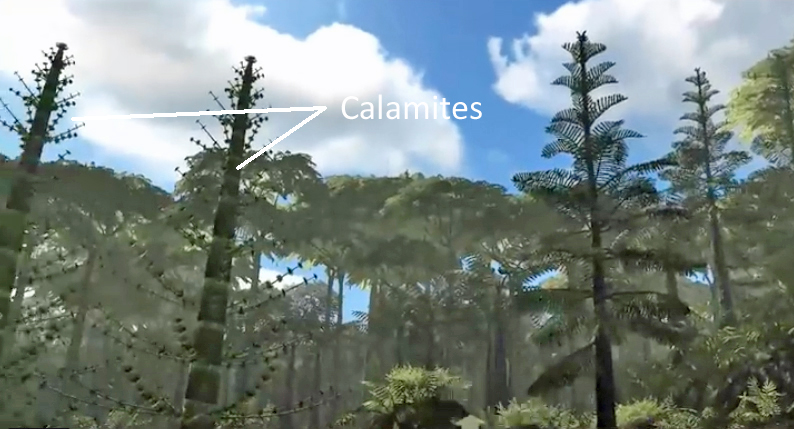
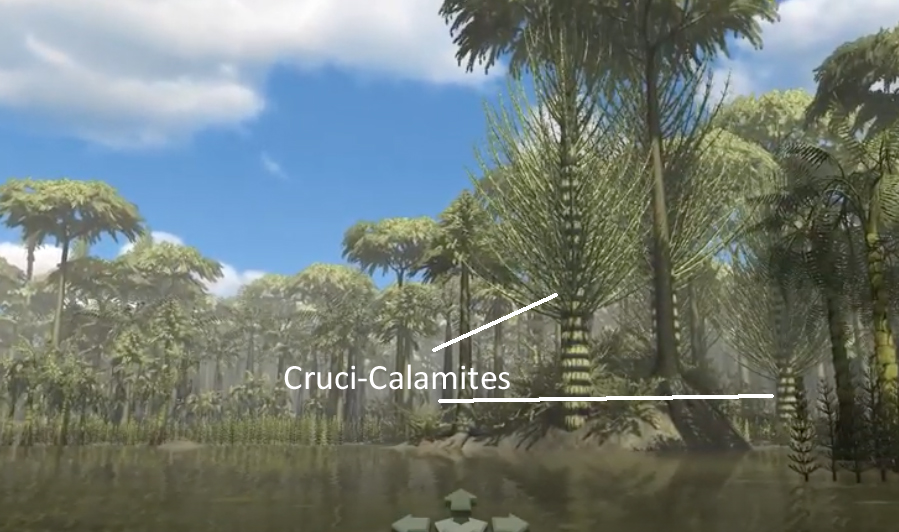

What Happened to the Calamites?
The remains of Calamites and other arborescent plants from the Carboniferous Period transformed into coal, currently being mined by the fossil fuel industry at great expense to our climate—which some suggest may return to conditions close to the Carboniferous or Permian Period.
Some scientists believe that the Calamites contributed to their own extinction. Because they were such efficient CO2 sinks, storing great quantities of atmospheric carbon dioxide in the soil, the Earth eventually cooled. With climate change, the hot, humid environment that supported Calamites gave way to the cooler drier environment of the Permian Period, which ushered in the reptiles, and led to what is called Carboniferous rainforest collapse. The Permian Period also ended an entire age with the greatest mass extinction the Earth has ever experienced.

Horsetails Today
As with its arborescent ancestor, the leaves of the common horsetail are arranged in whorls, fused into nodal sheaths. Its photosynthetic stems are hollow, jointed and ridged. Spores are borne under sporangiophores in a strobilus (plural: strobili), a cone-like structure at the tip of an unbranched stem. In Equisetum arvense (field horsetail) the cone-bearing shoots are non-photosynthetic, produced in early spring when I photographed several by the river.

The sporophyte of the Equisetum contains stem, leaves and roots. The stem runs underground as a rhizome and has two types of branches: 1) sterile, non-reproductive and photosynthetic; and 2) fertile and non-photosynthetic. Stem-branches of most horsetails grow 10-25 cm high with brown scale leaves and 10-40 mm long strobili (spore cones) that emerge in the spring. These eventually wither and give way to the sterile, photosynthetic branch-stems, which persist from summer until the first frost. The University of Puget Sound describes the fertile stem-branches, which appear early in spring, as brown, and having prominent sheaths at the nodes. “At the end of each one is a strobilus, the reproductive organ. Each strobilus is divided into multiple sporangiophores, which bear the spores. The spores are shed when elaters, ribbonlike structures to which they are attached, uncoil during dry conditions and shed them to the air. The spores that land in appropriate soil conditions germinate to form new plants.”

Prema Iswary of Premabotony.blogspot.com (who provides excellent information on Equisetum natural history and life cycle), shares that “under favourable conditions, the spore germinates and gives rise to normally monoecious gametophytic plant bodies.” These gametophytes are “long lived, green, thalloid and branched structures which grow on the wet soil and shaded regions.” But hard to find and identify!
E. arvense spreads largely from rhizomes, which can grow as deep as six feet. While most horsetail species typically grow to 25 cm and can be as high as 60 cm, the giant horsetail (Equisetum gigantum) and the Mexican giant horsetail (Equisetum myriochaetum) of Central and South America attain heights of 4 to 10 m (16 to 32 ft). The northern giant horsetail (Equisetum telmateia) of Europe, Asia and Africa reaches 30 to 150 cm high.
A few years ago, I went with good friend Margaret on a nature walk led by UBC Professor and botanist Terry McIntosh in the Pacific Spirit Forest Park—an old growth cedar-Douglas fir-Hemlock forest at the University of British Columbia in Vancouver, BC. McIntosh pointed out some 4-foot high horsetails (Equisetum sp.) flourishing amid Spirea and other native plants.
Equisetum arvense has a long history of cultural use with Native Americans and ancient Roman and Chinese physicians using it to treat a variety of ailments. It is still of interest today as an herbal remedy because of its purported effectiveness as a diuretic.
According to the University of Puget Sound, “the young shoots of horsetails are cooked and eaten in some cultures, including some Native Americans of the Pacific Northwest. This species is also used medicinally, being rich in minerals. On the negative side, it is a very successful plant, growing in a wide variety of moist environments including highly disturbed sites, and can be an invasive weed. Very few herbivores can eat it, perhaps because of the silica deposits in the stems, and it is resistant to most herbicides. Horsetails have been a success story for a long time.”
A few million years… And I predict a few million years more…
Shifting of Continents and Climate During the Paleozoic Era
The Paleozoic Era, which spanned several hundred million years, was a time of great change on Earth. Continents and climate shifted drastically. The era was warm and wet, without distinct seasons, and began (in the Cambrian Period) with the breakup of one supercontinent (Rodinia), the formation of another (Gondwana). ‘Floating’ fragments would eventually form today’s northern continents. Primitive life included flourishing marine life: planktonic algae, many invertebrates and the earliest fish and amphibians.
In the Cambrian Period (541 to 485 million years ago), Earth had no polar ice caps and was dominated by one supercontinent (Gondwana) and eight smaller continents, most located in the Southern Hemisphere. The climate was warm and wet without distinct seasons. Marine life flourished and major groups of invertebrates emerged, including the trilobites. Benthic crinoids filtered the abundant and diverse algal plankton with feather-like arms. Primitive vertebrates, jawless fish, emerged. In what many call the Cambrian explosion, living things developed hard structures (creating a legacy in the form of fossils).
In the Ordovician Period (485 to 444 million years ago), land masses that would become North America and northern Europe moved toward each other, creating shallow inland seas, and finally collided. The northern Africa part of Gondwana moved over the South Pole, triggering an ice age, lowering sea levels and emptying shallow seas, resulting in a mass extinction (80% of species living in the shallow seas went extinct). During the Ordovician Period, plants evolved from green algae and the first land plants, similar to mosses, appeared (heralding vertebrates to follow them).
In the Silurian Period (444 to 419 million years ago), Gondwana started moving away from the South Pole, ending the ice age and raising sea levels with a return of the shallow seas. The climate was similar to today’s with cold weather and glaciers near the South Pole and warmer weather near the equator. Small vascular plants appeared and became widespread. The first vertebrate animals (tetrapods) colonized land, mostly scorpions and millipedes.
In the Devonian Period (419 to 359 million years ago), three major continental masses occupied Earth, all moving toward each other. The North America/Europe continent (Laurasia) was near the equator; a portion of modern Siberia lay to the north; and Gondwana dominated the southern Hemisphere. With sea level still high, shallow seas dominated what would later become land. The Devonian Period is often called the “Age of the Fishes” given the great diversity of fish groups that evolved then, such as the first jawed fish, the Placoderms. With so much land near the equator, the climate was warm and mild; it was a greenhouse age. Sea life flourished in the warm seas and proto-amphibians developed such as Ichthyostega. The first trees and forests emerged. Ferns and seed-producing plants also evolved.

Seed ferns (Pteridospermatophyta) such as Odontopteris and Medullosa appeared in the late Devonian and flourished in the Carboniferous and Permian Periods. Medullosa grew as an upright unbranched woody trunk with a crown of large fernlike fronds. Ovules and pollen organs were attached to the fronds and gamete-producing structures in the seeds were surrounded by a hard inner integument and fleshy outer layer—possibly favoured by animals who would have dispersed them. One Medullosa, Pachytesta gigantea, grew seeds up to 7 cm long. As with tree ferns, these arborescent seed ferns were buttressed by extensive aerial roots. Another seed fern, Callistophyton was a woody vine that grew on other plants and produced seeds in a cupule-like structure.
Lycophytes organized their sporangia into strobili and contained vascular tissue in their leaves. Fossils of mycorrhizal fungi provide evidence that symbiosis of plants and fungi already occurred. The mass extinction of the late Devonian Period was more severe on marine life, with loss of reef habitat and cooling of marine waters through Gondwanan glaciation.
In the Carboniferous Period (359 to 299 million years ago), the continent of Gondwana moved close enough to North America/Europe (Laurasia) to cause uplift of the Appalachian Mountains. The period would end with the continental collision to create the super continent Pangaea. The early part of the Carboniferous experienced a uniform, tropical, wet climate with little seasonality. This changed as Gondwana reached the South Pole, triggering alternating glacial periods and major changes in sea levels; land near the equator remained moist and tropical. The shallow seas around each continent retreated over the period. Tetrapods began laying eggs, dragonflies such as Meganeuropsis ruled the skies, abundant roach-like “blattopterans” lived in leaf litter, conifers appeared (including the ginkgo), seed ferns became diverse, and amphibians grew in size and diversity. Several predatory amphibians such as the ten-foot long Eryopids resembled modern-day crocodiles, lizards and snakes. Armed with vicious teeth, they reached lengths of 6 metres (20 ft). Rebounding from the Devonian mass extinction, crinoids became dominant and diverse and helped rebuild the destroyed coral reefs. Fish divested themselves of Devonian armour and adopted ‘modern’ ray-fins, with the earliest bony fish, the Sturgeon-like palaeoniscoids, dominating the aquatic environment. Non-seed Lycophytes evolved into trees up to 40 m high and dominated the coal forests. Scientists estimate that up to 70% of coal material comes from lycophytes.
In the Permian Period (299 to 252 million years ago), the supercontinent Pangaea formed; the giant landmass that stretched from the North Pole to the South Pole, experienced wide variation in climate, with ice sheets at the poles, highly reduced shallow coastal seas and hot deserts in Pangaea’s interior. Climate and seasonal and daily temperature changed dramatically (perhaps greater than anything we see on the planet today). The coal swamps were doomed; they were replaced by temperate forests that contained abundant conifers. Swamp trees such as arborescent lycophytes and sphenopsids were replaced by gymnosperms and seed ferns. The swamp gymnosperm Cordaites disappeared. Amphibians dwindled; reptiles diversified and spread; precursors to mammals evolved. The end of the Permian Period coincided with the largest mass extinction of life on Earth; in what is called “the Great Dying”, 96% of all species perished. Evidence suggests that massive volcanic eruptions, meteor impacts, and/or rapid temperature increase due to a sudden release of methane from the ocean bottoms may have contributed to this extinction.
The Permian/Triassic mass extinction event was the second of five mass extinction events to occur in Earth’s over five hundred million year history (the first recorded extinction event took place at the end of the Ordovician Period. Another would occur at the end of the Triassic and the fifth at the end of the Cretaceous, some 66 mya. Causes of all these extinction events, most of which occurred over millions of years, certainly involved some combination of climate change (temperature crises, ocean warming, acidification, sulfide poisoning and hypoxia), Earth movement and shifting continents, volcanic activity, and possible asteroid impacts. The situation in the late Permian, of increasing atmospheric greenhouse gases creating warmer temperatures on Earth, is similar to today.
Here’s how The Guardian neatly summarizes the five mass extinctions:

According to many scientists, we are currently experiencing the sixth extinction event. Also called the Holocene-Anthropocene Extinction, some call what is happening a “biological annihilation.” Scientists agree that the present extinction rate is thousands of times higher than the natural baseline rate. The baseline is about one species per every one million species per year; currently that rate is one in a thousand. This translates to 10,000 to 100,000 species becoming extinct each year.
If this isn’t sufficiently alarming, we are not only witnessing an increase in extinction rate but a loss of total population and distribution of common species–which is even more alarming. Scientists analysing both common and rare species have found billions of regional and local populations lost in recent years. In a study by Gerardo Ceballos published in the Proceedings of the National Academy of Sciences, half of the 177 mammal species surveyed lost more than 80% of their distribution between 1900 and 2015. “Scientists found that a third of the thousands of species losing populations are not currently considered endangered and that up to 50% of all individual animals have been lost in recent decades,” reports The Guardian. “Detailed data is available for land mammals, and almost half of these have lost 80% of their range in the last century.”

Most scientists agree that the sixth mass extinction is caused by human activity (which includes unsustainable use of land, water and energy) and human-induced climate change. Extreme global biodiversity loss over the past 50 years has been mostly driven by habitat destruction to do with clearing of forests for farmland, the expansion of roads and cities, logging, hunting, overfishing, water pollution and transport of invasive species around the globe.
Will we survive the 6th Mass Extinction? I’m not sure. But I’ll bet good money on Equisetum…

Nina Munteanu is a Canadian ecologist / limnologist and novelist. She is co-editor of Europa SF and currently teaches writing courses at George Brown College and the University of Toronto. Visit www.ninamunteanu.ca for the latest on her books. Nina’s bilingual “La natura dell’acqua / The Way of Water” was published by Mincione Edizioni in Rome. Her non-fiction book “Water Is…” by Pixl Press(Vancouver) was selected by Margaret Atwood in the New York Times ‘Year in Reading’ and was chosen as the 2017 Summer Read by Water Canada. Her novel “A Diary in the Age of Water” was released by Inanna Publications (Toronto) in June 2020.
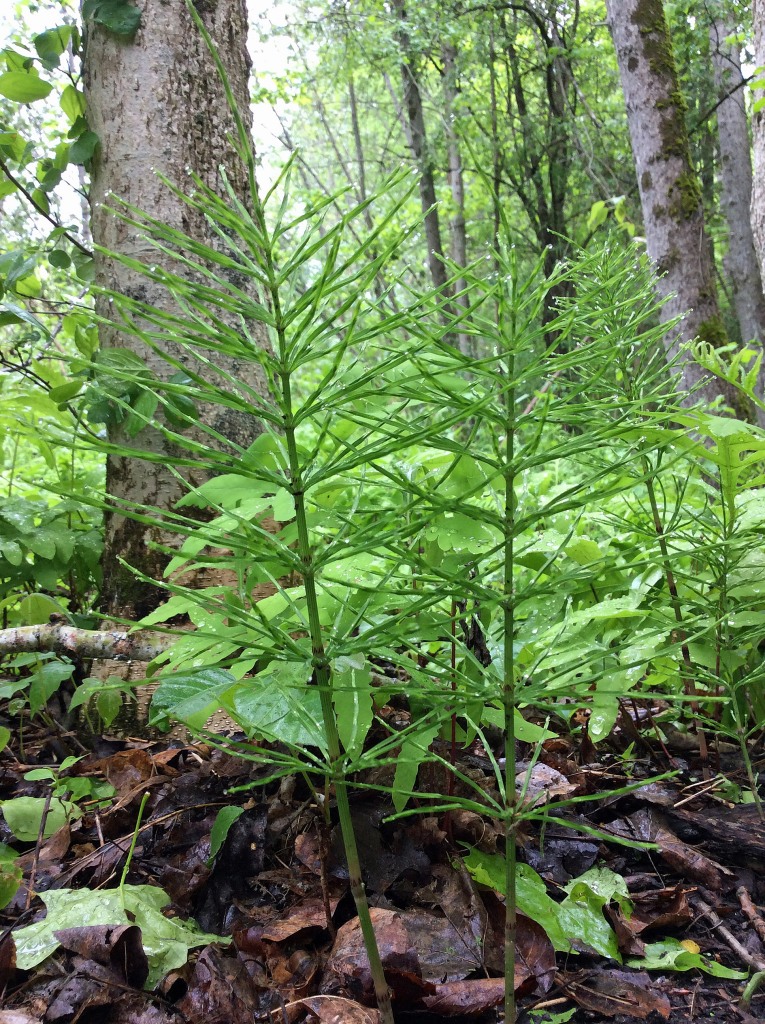






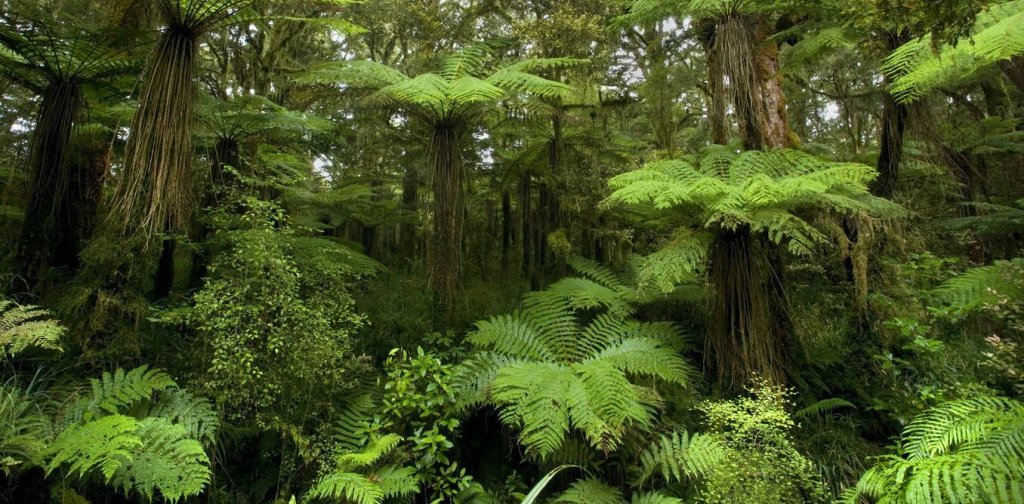







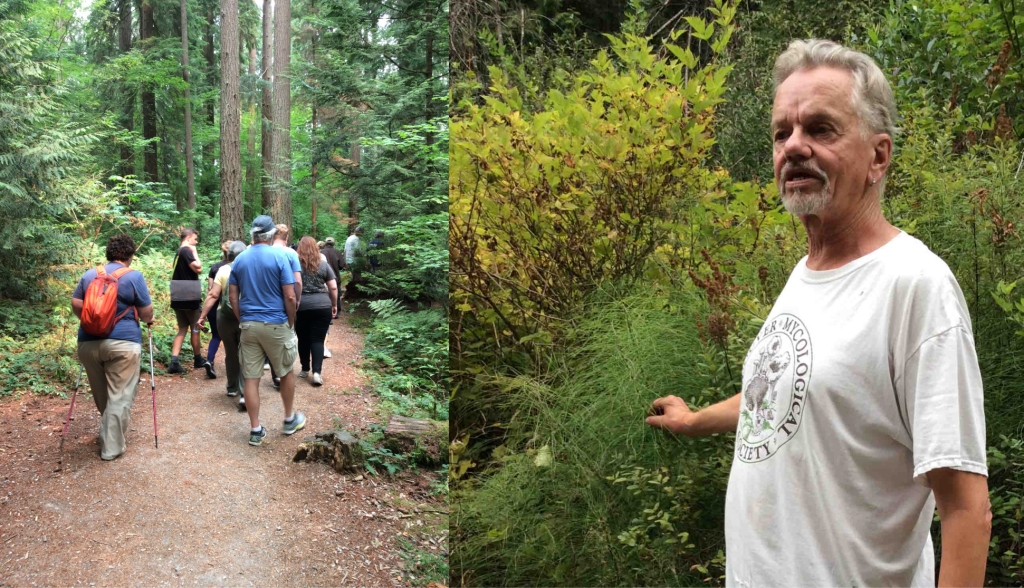

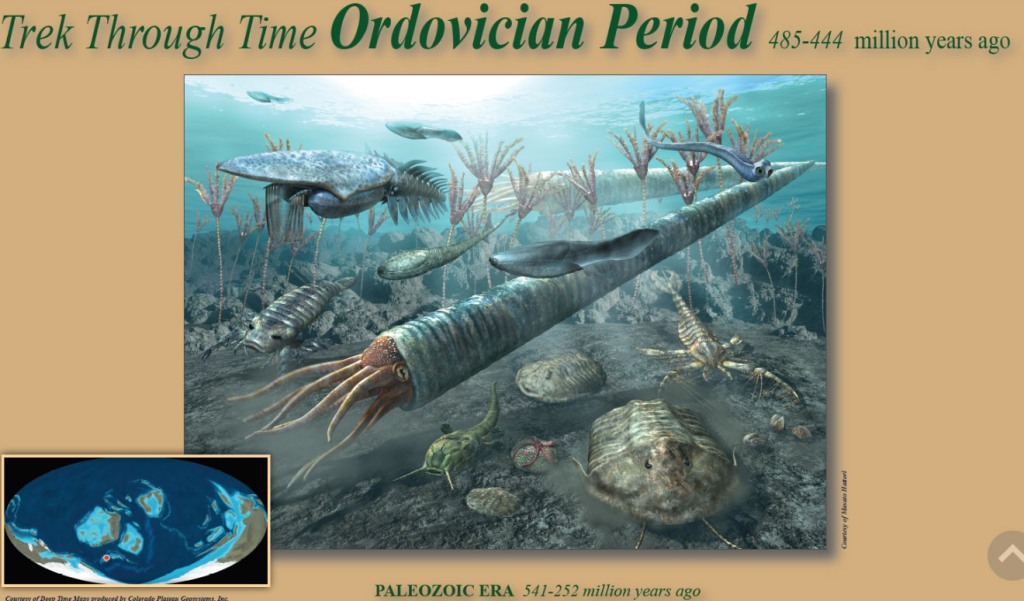





hi 👋 I’m the artist who created the arthropleura image, but it appears Nature Was Metal must’ve posted it without properly attributing it to me, it would be nice if the source can be edited to attribute it to me, thankyou.
-Kiabugboy
LikeLike
Hi Aldrich, I’ve changed the attribution to Kiabugboy with a link to your DeviantArt site. Thanks for letting me know. Your art is wonderful! Best Wishes, Nina
LikeLike